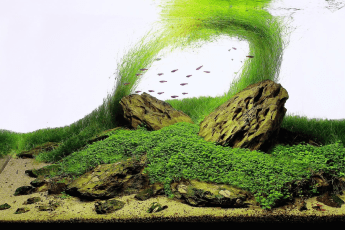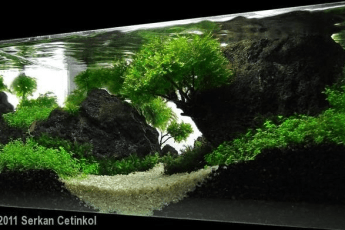Aquascaping is an art form that involves arranging aquatic plants, rocks, driftwood, and other elements in a way that mimics natural underwater landscapes. One of the key principles in successful aquascaping is the thoughtful arrangement of elements in the foreground, midground, and background. These three layers play a crucial role in creating depth, visual interest, and a harmonious aquatic environment.
Foreground: The Canvas’s Edge
The foreground in aquascaping refers to the area closest to the viewer, typically the front of the aquarium. This area serves as the canvas’s edge, framing the entire aquascape. When designing the foreground, consider using smaller plants, low-growing carpeting plants, or hardscape elements like rocks and driftwood. These elements add detail and texture to the immediate front of the tank, creating a sense of proximity and intimacy.
a. Carpeting Plants:
Carpeting plants are often used in the foreground to create a lush, green carpet that mimics the look of a natural meadow. Species like Hemianthus callitrichoides (HC), Eleocharis parvula (Dwarf Hairgrass), or Monte Carlo are popular choices. These plants should be trimmed regularly to maintain a neat and uniform appearance.
b. Hardscape in the Foreground:
Rocks and driftwood strategically placed in the foreground can add visual interest. However, it’s crucial not to overcrowd this area, as it may obstruct the view of the midground and background.
Midground: The Heart of the Composition
The midground is the central area of the aquarium, sandwiched between the foreground and background. This layer plays a pivotal role in connecting the entire aquascape, providing a transition between the smaller elements in the foreground and the larger, more prominent features in the background.
a. Medium-Sized Plants:
Choose medium-sized plants with varying heights for the midground. This creates a sense of depth and adds complexity to the overall composition. Species like Cryptocoryne, Anubias, or Echinodorus are excellent choices for the midground.
b. Driftwood and Rocks:
Larger pieces of driftwood or rocks placed in the midground can serve as focal points. These elements should complement the surrounding plants and contribute to the overall theme of the aquascape. Ensuring that these elements flow naturally with the design helps maintain a cohesive and balanced appearance.
Background: Creating Depth and Perspective
The background is the area farthest from the viewer and is crucial for establishing depth and perspective in the aquarium. Taller plants and larger hardscape elements are commonly used in this layer.
a. Tall Stem Plants:
Select tall and slender stem plants such as Vallisneria, Rotala, or Ludwigia for the background. These plants create a vertical element that adds height to the aquascape, emphasizing the sense of scale and distance.
b. Large Rocks and Driftwood:
Incorporate larger rocks or driftwood pieces in the background to anchor the composition. These elements should be placed strategically to enhance the overall visual flow without overshadowing the midground or foreground.
Conclusion:
Understanding the importance of foreground, midground, and background in aquascaping is essential for creating a captivating underwater landscape. By carefully selecting and arranging plants, rocks, and driftwood in each layer, aquascapers can achieve a harmonious and visually stunning aquarium that replicates the beauty of nature. Experimentation and creativity are key, allowing aquascapers to express their individual style while adhering to the principles of balance, depth, and perspective.



